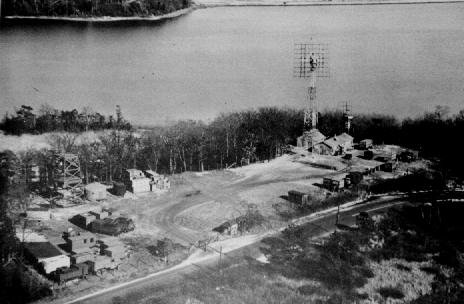Editor’s note: The following article and images are reprinted with permission from the InfoAge Science & History Museums website at InfoAge.org. The InfoAge complex houses a surprising array of museums and exhibits on a variety of subjects, but it is also a living history museum, the site where great scientific advancements were made. Click here to read our Timeline story about this amazing Monmouth County landmark.
Monmouth University Professor Melissa Ziobro has provided Monmouth Timeline with the first installment of a new story about Dr. Walter McAfee, a mathematician, scholar and scientist who played a key role in the Diana project. Click here to read this chapter in this great story.
Diana RADAR is the bed-spring like device to the right of center Camp Evans in the image above. Camp Evans Opened the Space Age in January 1946 with Project Diana.
In late 1945, in the lull that followed the Japanese surrender, a number of scientists at Fort Monmouth’s Camp Evans began working on a way to pierce the earth’s ionosphere with radio waves, a feat that had been tried just before the war without success and which many thought impossible. Project Diana, named for the goddess of the moon, was designed to prove that it could be done. Begun on an almost unofficial level by Evans radar scientists awaiting their Army discharge, the project was headed by Lt. Col. John DeWitt. Operating with only a handful of full-time researchers, the project scientists greatly modified an SCR-271 bed-spring radar antenna, set it up in the northeast corner of Camp Evans, jacked up the power, and aimed it at the rising moon on the morning of January 10, 1946. A series of radar signals were broadcast, and in each case, the echo was picked up in exactly 2.5 seconds, the time it takes light to travel to the moon and back.
The importance of Project Diana cannot be overestimated. The discovery that the ionosphere could be pierced and that communication was possible between earth and the universe beyond, opened the possibility of space exploration that previously had been only a dream in adventure films and comic books. Just as Hiroshima opened the nuclear age in 1945, Project Diana opened the space age in January of 1946. It would take another decade before the first satellites were launched into space, soon followed by manned rockets, but Diana paved the way for all those achievements. It even initiated the tradition of naming such projects after ancient Greek and Roman gods, like Mercury and Apollo. For Fort Monmouth Project Diana was a pivotal event that built on World War II expertise but pointed the way to the future.
Above summary from “Evaluation of Selected Cultural Resources At Fort Monmouth, New Jersey: Context For Cold War Era, Revision of Historic Properties Documentation, and Survey of Evan Area and Sections of Camp Charles Wood” by Mary Beth Reed and Mark Swanson, New South Associates June 1996 U.S. Army Corps of Engineers, Fort Worth District.
Technical Articles by Project Diana Team in the InfoAge archives:
- January 1946 technical article with photos – ‘Radar Echoes From the Moon’ By Jack Mofenson
Thanks to Harry Visser, who created the page and gave us permission to use it on our site.
The article is a “Detailed description of the techniques underlying the first recorded radio transmission through outer space. Calculations show that the maximum range of the Signal Corps radar on lunar target exceeds one million miles.”
- Herbert Kauffman authored “A DX Record: To the Moon and Back, How the Moon-Radar Feat was Accomplished.” Thanks to Russ Brahn, AE2X, we have a copy.
- First Radar Detection of the Moon (482-485), by E. King Stodola, from: “Some Examples of Post-World War II Radar in the USA,” thanks to Cynthia S. Pomerleau.
Audio and film resources available:
Audio Radio Broadcast of Interview of Project Diana team, including replication of the moon shot (1946). Thanks to Cynthia S. Pomerleau.
Audio October 3-4, 1979 Interview of E. King Stodola, conducted by Cynthia S. Pomerleau.
A 1946 WOR radio broadcast of the Diana Moonshot (727KB). Thanks to Cynthia S. Pomerleau.
16mm film: “Radar contacts the Moon,” on file Fort Monmouth Command Historian Collection.
In 1958, NY Times Radio and Television Editor Jack Gould authored a children’s book in the “All About Books” series printed by Random House. Chapter 17 tells the story of radar and Project Diana. Thanks to David Mofenson who sent us this.
A story on Diana by author Art Scott.
Source: Reed, Mary Beth & Swanson, Mark. (1996). Evaluation of Selected Cultural Resources At Fort Monmouth, New Jersey: Context For Cold War Era Revision of Historic Properties Documentation, and Survey of Evans Area and Sections of Camp Charles Wood. New South Associates, U.S. Army Corps of Engineers, Fort Worth District, June 1996. Available: https://infoage.org/history-ia/army-research/project-diana-january-10-1946/


Leave a Reply